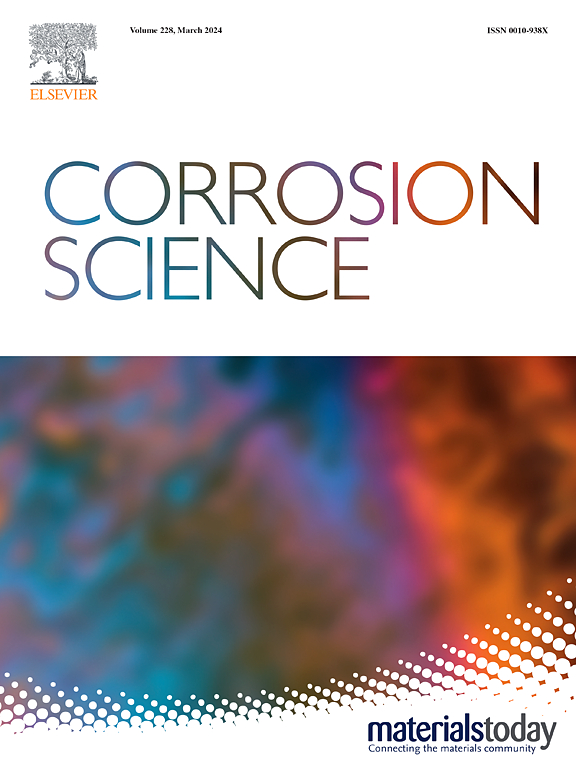煤粉-氨共烧条件下近壁还原气氛NH3-H2S-O2-CO-N2中水壁管材料高温腐蚀行为的实验研究
IF 7.4
1区 材料科学
Q1 MATERIALS SCIENCE, MULTIDISCIPLINARY
引用次数: 0
摘要
本研究旨在阐明水壁管材料(12Cr1MoV)在H2S-NH3-O2-CO-N2球近壁还原气氛中400/500℃的腐蚀行为。暴露时间为168 h,这与煤粉锅炉与氨共燃的条件密切相关。在相同NH3浓度为5 %的还原性气氛下,试样在500℃下的腐蚀比在400℃下的腐蚀更严重。由于氨还原,价态氧化铁的硫化反应随着温度的升高而明显加快。随着还原气氛中NH3浓度从0.5 %增加到5 %,试样在400/500℃下暴露168 h后的最终质量增益明显增加。在400℃低NH3暴露气氛下,腐蚀过程中主要发生铁及其硫化物的氧化反应。在低温条件下,当NH3浓度为10 %时,氮、硫元素对基体金属的渗透程度要大于O元素。穿透后的NH3可以直接与铁基体反应生成Fe4N,这在热力学上是有利的。暴露气氛中每24 h NH3的存在与缺失周期交替加速了试样在400℃下的腐蚀。在还原气氛中,当O2浓度从0.1 %增加到0.5 %时,试样在400℃的腐蚀速率略有抑制。腐蚀产物Fe2O3在400/500℃的氨还原过程为:Fe2O3→Fe3O4→Fe→Fe4N。本文章由计算机程序翻译,如有差异,请以英文原文为准。
Experimental study of high temperature corrosion behavior of water-wall tube material in the near-wall reducing atmosphere of NH3-H2S-O2-CO-N2 under pulverized coal-ammonia cofiring condition
This study aimed to clarify the corrosion behavior of water-wall tube material (12Cr1MoV) at 400/500℃ in a near-wall reducing atmosphere of H2S-NH3-O2-CO-N2 bal. after exposure time of 168 h, which is closely associated with the conditions of pulverized coal boilers cofiring with ammonia. Corrosion of specimens at 500℃ was more severe than that at 400℃ in the reducing atmosphere with a same NH3 concentration of 5 %. The sulfidation reaction of iron oxide with low valence states due to ammonia reduction was highly promoted by elevating temperature. With the NH3 concentration increasing from 0.5 % to 5 % in the reducing atmosphere, the final mass gain of specimens at 400/500℃ after exposed time of 168 h was obviously increased. Oxidation reaction of iron and its sulfides was dominated during corrosion process at 400℃ in the exposure atmosphere with low NH3 concentration. Higher NH3 concentration of 10 % at low temperature could promote the penetration of N and S elements into base metal more deeply than O element. The penetrated NH3 could directly react with iron matrix to generate Fe4N, which is thermodynamically favored. The periodical alternation of NH3 presence and absence per 24 h in exposure atmosphere accelerated the corrosion of specimens at 400℃. While the O2 concentration increased from 0.1 % to 0.5 % in the reducing atmosphere, the corrosion rate of specimens at 400℃ could be slightly inhibited. The reduction pathway of corroded product Fe2O3 by ammonia follows a same step: Fe2O3→ Fe3O4→ Fe →Fe4N at 400/500℃.
求助全文
通过发布文献求助,成功后即可免费获取论文全文。
去求助
来源期刊

Corrosion Science
工程技术-材料科学:综合
CiteScore
13.60
自引率
18.10%
发文量
763
审稿时长
46 days
期刊介绍:
Corrosion occurrence and its practical control encompass a vast array of scientific knowledge. Corrosion Science endeavors to serve as the conduit for the exchange of ideas, developments, and research across all facets of this field, encompassing both metallic and non-metallic corrosion. The scope of this international journal is broad and inclusive. Published papers span from highly theoretical inquiries to essentially practical applications, covering diverse areas such as high-temperature oxidation, passivity, anodic oxidation, biochemical corrosion, stress corrosion cracking, and corrosion control mechanisms and methodologies.
This journal publishes original papers and critical reviews across the spectrum of pure and applied corrosion, material degradation, and surface science and engineering. It serves as a crucial link connecting metallurgists, materials scientists, and researchers investigating corrosion and degradation phenomena. Join us in advancing knowledge and understanding in the vital field of corrosion science.
 求助内容:
求助内容: 应助结果提醒方式:
应助结果提醒方式:


